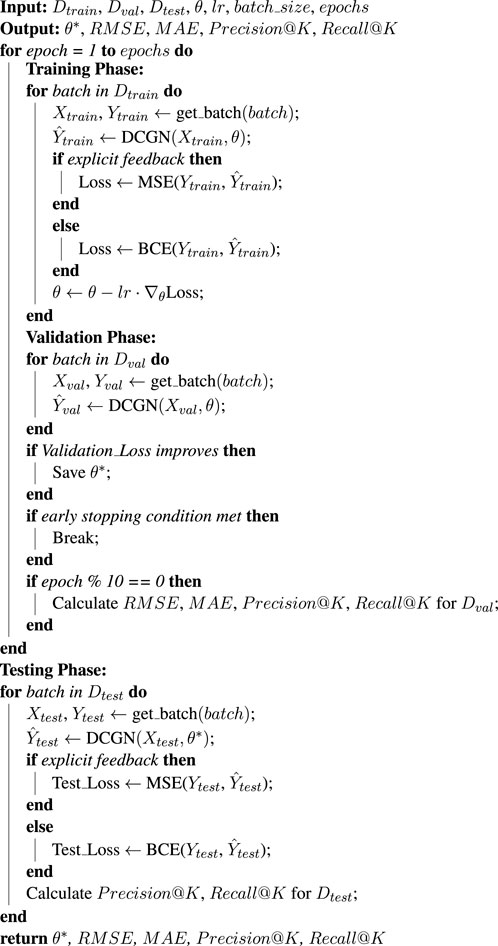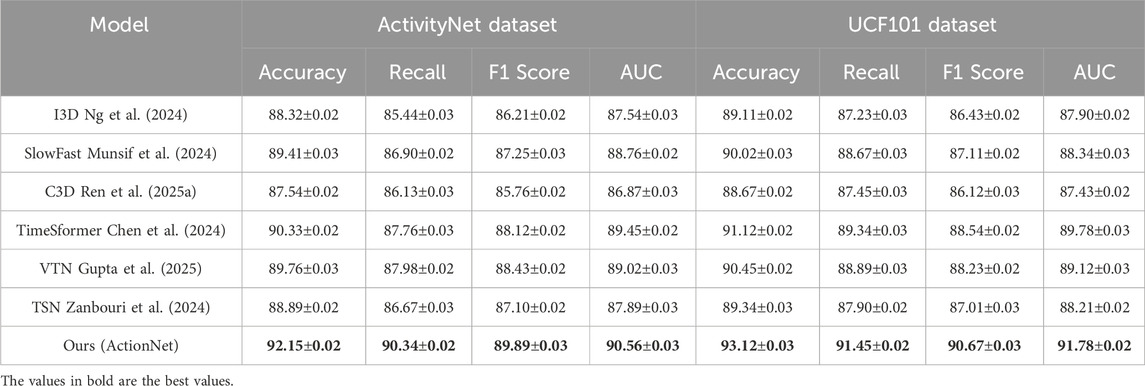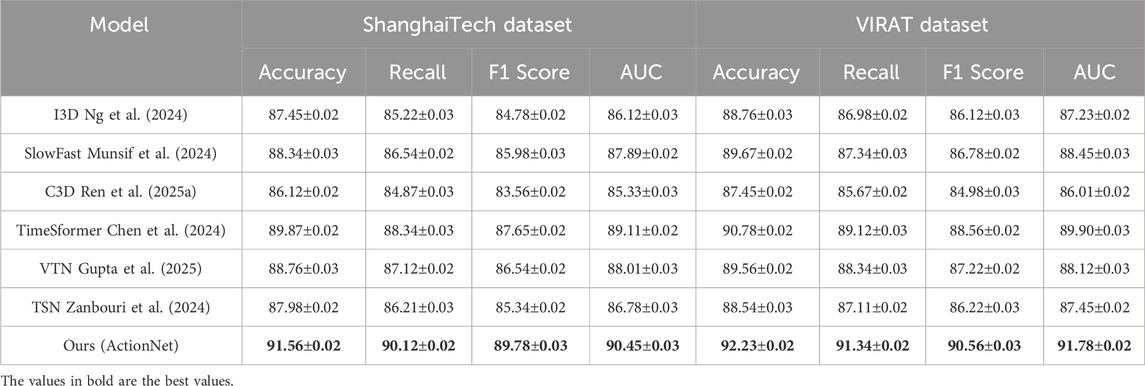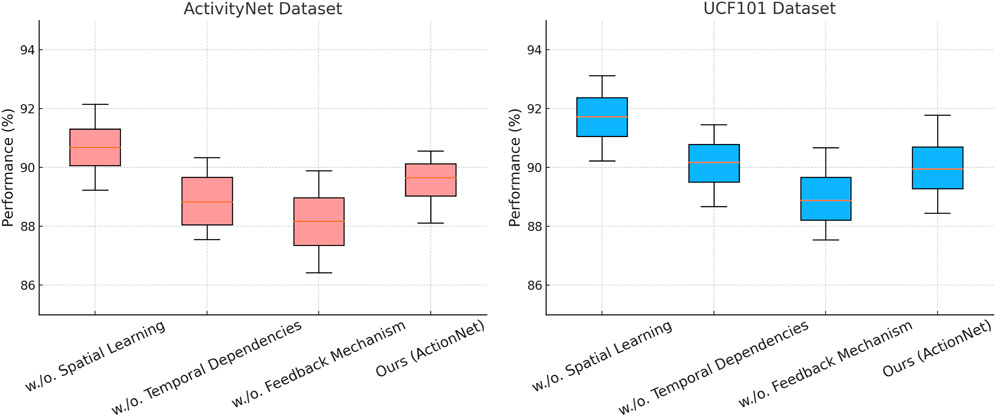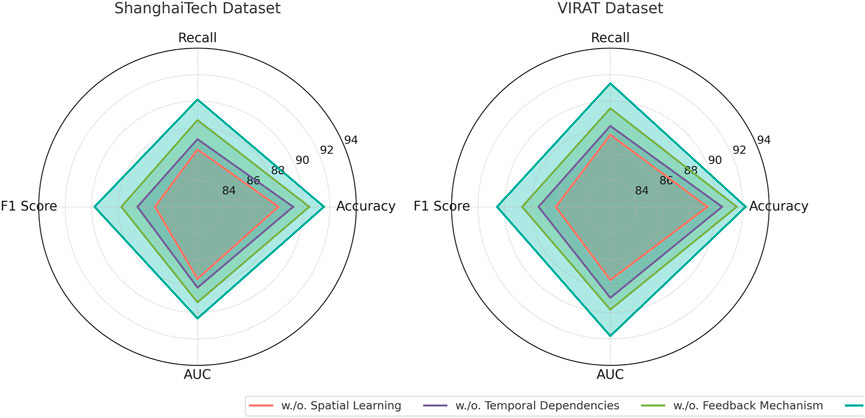- 1School of Resources and Environment, Xizang Agriculture and Animal Husbandry University, Nyingchi, Xizang, China
- 2Department of Mechanical Engineering, Taiyuan Institute of Technology, TaiYuan, China
Background: The increasing urgency to mitigate and adapt to climate change demands innovative methodologies capable of analyzing complex climate systems and informing policy decisions. Traditional climate action models often struggle with capturing intricate spatial-temporal dependencies and integrating multi-modal data, resulting in limited scalability and real-world applicability.
Methods: To address these challenges, we propose a novel framework that integrates the Dynamic Climate Graph Network (DCGN) with the Adaptive Climate Action Strategy (ACAS). DCGN utilizes graph-based learning to model spatial dependencies and temporal feature extraction to analyze evolving climate patterns. Multi-modal data fusion is employed to integrate meteorological, socio-economic, and geospatial information. ACAS builds upon DCGN’s predictive outputs by applying attention mechanisms and optimization under domain-specific constraints to prioritize high-impact regions and variables.
Results: Empirical results demonstrate that the proposed framework consistently outperforms several state-of-the-art baselines across multiple benchmark datasets, achieving an average improvement of over 2.5% in F1 Score and AUC. These outcomes highlight the robustness, generalizability, and real-world applicability of our approach.
Conclusion: By linking advanced machine learning techniques with interpretable and actionable climate policy insights, the integrated DCGN–ACAS framework provides a scalable and effective tool for climate risk assessment and low-carbon transition strategies. The proposed method offers promising implications for sustainable urban planning, environmental governance, and adaptive climate intervention.
1 Introduction
Action recognition, a subfield of computer vision, has emerged as a critical tool for assessing human activities in the context of climate risk and the development of low-carbon economic policies (Chen Y. et al., 2021). The ability to accurately detect and interpret human actions is integral to analyzing behaviors that contribute to environmental changes and understanding the socio-economic impacts of climate risks (Duan et al., 2021). This research area is vital not only for monitoring industrial activities, urban mobility patterns, and agricultural practices but also for supporting evidence-based policy-making (Liu et al., 2020). Action recognition can enable more effective mitigation strategies by identifying high-emission activities, promoting sustainable practices, and informing adaptive responses to climate risks (Cheng et al., 2020b). It offers innovative possibilities to bridge the gap between environmental science and economics by linking human activities with emissions data, thus providing actionable insights for transitioning to low-carbon economies (Zhou et al., 2023). As climate risks intensify and the urgency for sustainable solutions grows, advancing action recognition technologies tailored to these contexts becomes a pressing need.
Early approaches to action recognition for climate-related applications relied on symbolic AI and rule-based systems (Li et al., 2020). These methods primarily used handcrafted features and logic-based representations to model human actions and correlate them with environmental impacts (Morshed et al., 2023). For instance, systems were developed to monitor industrial machinery operations or track urban traffic patterns using predefined sets of motion rules and activity patterns (Perrett et al., 2021). These approaches were particularly useful in structured environments, where activities followed predictable patterns (Yang et al., 2020). Their reliance on domain experts to define rules and features made them less adaptable to dynamic and complex real-world scenarios. Symbolic methods struggled to process and integrate large-scale data streams, such as those generated by surveillance cameras or IoT sensors in urban areas (gun Chi et al., 2022). As a result, their applicability was limited to narrow, well-defined use cases, impeding their scalability and effectiveness in addressing the broader challenges of climate risk assessment and low-carbon policy development.
To overcome the rigidity of symbolic methods, machine learning (ML) approaches were introduced, marking a significant shift toward data-driven action recognition (Wang et al., 2020). Algorithms such as Hidden Markov Models (HMMs), Support Vector Machines (SVMs), and Random Forests were employed to classify human activities based on patterns extracted from labeled datasets (Pan J. et al., 2022). These methods proved particularly effective for recognizing common actions, such as identifying energy-intensive behaviors or monitoring compliance with environmental regulations in industrial settings (Song et al., 2021). Machine learning models were used to analyze worker movements in factories to optimize energy consumption and reduce carbon footprints (Chen Z. et al., 2021). While these methods demonstrated improved adaptability and scalability, they faced challenges in capturing the complexity of actions across diverse environmental and socio-economic contexts (Ye et al., 2020). The reliance on labeled data posed additional limitations, as collecting and annotating datasets representative of global activities is time- and resource-intensive. Traditional ML models struggled to incorporate temporal and contextual information critical for understanding the nuances of climate-related human actions.
The emergence of deep learning and pre-trained models has transformed action recognition by facilitating the automatic extraction of intricate spatiotemporal features from raw data (Sun et al., 2020). Deep neural networks (DNNs), including Convolutional Neural Networks (CNNs) and Recurrent Neural Networks (RNNs), have been employed to analyze video sequences and infer high-level action representations (Duan et al., 2022). Pre-trained models such as I3D (Inflated 3D ConvNet) and ST-GCN (Spatio-Temporal Graph Convolutional Networks) have been adapted for climate-related applications, such as monitoring deforestation activities, detecting illegal fishing, or assessing energy usage behaviors (Zhang et al., 2020). These methods offer unparalleled accuracy and generalizability, even in unstructured and noisy environments (Lin et al., 2020). For instance, deep learning has been used to identify sustainable farming practices from drone footage or to detect violations of emissions regulations through automated surveillance systems (Song et al., 2020). Challenges remain, particularly regarding the high computational requirements of deep models and the ethical implications of deploying surveillance technologies on a large scale. These models often function as black boxes, limiting their interpretability and trustworthiness in policy-making contexts where transparency is paramount.
To address the limitations of existing methods, we propose an action recognition framework specifically tailored to climate risk assessment and low-carbon economic policy responses. Our approach integrates domain-specific knowledge with the latest advancements in spatiotemporal deep learning, enabling robust, context-aware action recognition. By leveraging pre-trained models fine-tuned on curated climate-related datasets, our framework enhances accuracy and reduces the data collection burden. We incorporate graph-based methods, such as Graph Neural Networks (GNNs), to model the interdependencies between human actions and environmental factors, providing a more holistic understanding of their impacts. This hybrid approach ensures scalability across diverse geographic and socio-economic contexts, addressing the challenges of generalizability and data scarcity. We prioritize model interpretability through explainable AI techniques, enabling policymakers to understand the rationale behind the framework’s predictions and make informed decisions. Our method not only advances the field of action recognition but also serves as a powerful tool for mitigating climate risks and fostering sustainable economic practices. Despite the advancements in deep learning and spatiotemporal modeling, a significant research gap remains in integrating multi-modal climate data with interpretable and adaptive action frameworks tailored specifically to climate risk and low-carbon economic policy contexts. Existing approaches often lack the capability to holistically model spatial-temporal dependencies while maintaining scalability, interpretability, and real-world policy relevance. To address this gap, this study proposes a novel framework that integrates the Dynamic Climate Graph Network (DCGN) and the Adaptive Climate Action Strategy (ACAS). The key contributions of this work are threefold: (1) DCGN utilizes graph-based learning to capture complex spatial dependencies among climate-related variables while incorporating temporal feature extraction to identify evolving patterns; (2) the model employs multi-modal fusion to integrate heterogeneous climate, socio-economic, and geospatial data, thus enabling comprehensive and nuanced assessments of climate dynamics; and (3) ACAS translates the predictive insights into actionable and interpretable policy guidance through attention mechanisms, which prioritize high-impact regions and variables for decision-making. This integrated approach not only improves performance over state-of-the-art baselines but also delivers practical tools for governments and organizations seeking scalable and effective responses to climate risks and emissions reduction challenges.
2 Related work
2.1 Action recognition in climate risk assessment
The use of action recognition in climate risk assessment has gained increasing attention due to its ability to capture human-environment interactions and their implications for disaster preparedness and mitigation (Ren X. et al., 2025). Action recognition systems, powered by computer vision and machine learning, analyze human behaviors in response to environmental hazards such as floods, wildfires, and hurricanes. These systems provide critical data for understanding evacuation behaviors, hazard responses, and adaptive actions, which are essential for designing effective risk management strategies (Munro and Damen, 2020). In the context of flood risk assessment, action recognition algorithms have been employed to analyze evacuation footage, identifying patterns such as hesitation, crowd movement bottlenecks, and non-compliance with emergency protocols. These insights help policymakers optimize evacuation plans and allocate resources efficiently (Zhang and Song, 2025). During wildfire events, action recognition systems have been used to monitor fire suppression activities, enabling the evaluation of response strategies and their alignment with real-time conditions. The integration of drone footage and satellite data with action recognition models has further enhanced the ability to analyze human activities over large and inaccessible areas, offering a holistic perspective on disaster response (Wang et al., 2022). Action recognition is being applied to assess community-level adaptation practices in the face of climate change (Change, 2022). For instance, the adoption of sustainable farming practices, water conservation efforts, and community-led disaster mitigation activities can be quantified through action recognition frameworks. These systems not only measure the prevalence of such actions but also identify barriers to their widespread adoption. By analyzing large-scale behavioral data, researchers can provide actionable recommendations for fostering resilience to climate risks (Yang et al., 2022). A particularly promising avenue is the coupling of action recognition data with predictive modeling for climate risk scenarios. By observing real-world human actions during simulated climate hazards, researchers can calibrate models to better predict future vulnerabilities and adaptation needs (Dave et al., 2022). This integration is critical for informing policies that address the dual challenges of immediate disaster response and long-term climate resilience.
2.2 Behavioral insights for low-carbon transitions
Action recognition is increasingly being utilized to study behavioral patterns that influence the transition to low-carbon economies. Human actions, such as energy consumption habits, transportation choices, and waste management practices, play a pivotal role in determining the success of decarbonization policies. By employing action recognition systems to analyze these behaviors, policymakers can design targeted interventions that promote sustainable practices (Xing et al., 2022). Action recognition has been employed to track and analyze energy consumption behaviors in both residential and industrial settings. For instance, tracking actions such as appliance usage, thermostat adjustments, and lighting habits enables the identification of inefficiencies and the tailoring of energy-saving initiatives. Smart home technologies equipped with action recognition capabilities provide real-time feedback to users, encouraging more sustainable energy consumption. In industrial settings, these systems optimize operations by detecting energy-intensive actions, facilitating the implementation of energy management systems that align with carbon reduction goals (Wang et al., 2021). Transportation behavior analysis is another critical application. Action recognition frameworks have been deployed to study commuter behaviors, such as carpooling, public transportation usage, and active travel methods like walking and cycling (Ren et al., 2024b). These systems provide granular insights into barriers to low-carbon transportation adoption, such as infrastructure gaps or behavioral inertia. Based on this data, policymakers can prioritize investments in public transit networks, bike lanes, and incentive programs to encourage shifts toward sustainable mobility (Liu et al., 2025). Action recognition is proving valuable in waste management and circular economy initiatives. By analyzing behaviors related to recycling, composting, and material reuse, these systems identify areas where public awareness campaigns or policy incentives are needed. For instance, the misclassification of waste items in recycling bins can be addressed through targeted education campaigns informed by behavioral data. Action recognition systems have been used to evaluate the effectiveness of pay-as-you-throw waste reduction policies, providing evidence-based feedback for refining such measures (Meng et al., 2020). The integration of action recognition with behavioral economics is further advancing the understanding of low-carbon transitions. By combining observational data with insights from nudge theory and incentive structures, researchers can develop comprehensive strategies for accelerating the adoption of sustainable behaviors. These approaches align individual actions with broader societal goals, ensuring a smoother transition to a low-carbon economy.
2.3 Policy design using action recognition data
The data generated by action recognition systems is becoming an invaluable resource for designing and evaluating policies aimed at addressing climate risks and fostering low-carbon development. By capturing real-time human behaviors in diverse contexts, these systems provide empirical evidence that informs the development of adaptive and equitable policy responses (Truong et al., 2022). In climate risk policy, action recognition data is used to evaluate the effectiveness of disaster preparedness and response initiatives. Video analysis of evacuation drills and emergency responses provides insights into the operational efficiency of existing protocols. Policymakers can leverage these insights to refine evacuation routes, improve early warning systems, and allocate resources more effectively. Action recognition has been employed to assess community participation in disaster risk reduction activities, ensuring that vulnerable populations are adequately included in planning processes (Bao et al., 2021). For low-carbon policy design, action recognition offers a robust method for monitoring compliance and measuring impact. Carbon pricing policies, can be evaluated by analyzing shifts in consumer behaviors, such as reduced vehicle usage or increased adoption of energy-efficient appliances (Ren et al., 2024a) the effectiveness of renewable energy incentives can be assessed by tracking the installation and use of solar panels, wind turbines, and other clean technologies. This real-time monitoring capability allows for dynamic adjustments to policy measures, ensuring they remain effective and equitable. action recognition data supports the design of just transition policies that address the social and economic impacts of decarbonization (Li et al., 2025). By observing workforce behaviors and retraining efforts, these systems provide evidence on the effectiveness of programs aimed at transitioning workers from carbon-intensive industries to green jobs. For instance, tracking participation in skill-building workshops or on-the-job training programs informs the scaling of successful initiatives and the redesign of underperforming ones (Cheng et al., 2020a). The integration of action recognition data with geospatial and socioeconomic datasets enhances the granularity of policy analysis. By linking observed behaviors with demographic and geographic variables, researchers can identify disparities in access to climate adaptation resources or low-carbon technologies (Pan A. et al., 2022). These insights enable the tailoring of policies to address specific regional and community needs, promoting equity in the face of climate challenges. As action recognition technologies continue to evolve, their role in shaping evidence-based and adaptive policy responses is poised to expand significantly.
3 Methods
3.1 Overview
Climate action analysis has emerged as a critical domain where data-driven methodologies play an essential role in understanding, mitigating, and adapting to the challenges of climate change. The increasing availability of diverse climate-related datasets, including satellite imagery, environmental sensor data, and socio-economic indicators, offers unprecedented opportunities for applying artificial intelligence (AI) and machine learning (ML) techniques to advance climate science and policy. This paper introduces a novel framework for climate action analysis that integrates domain knowledge, computational efficiency, and interpretability to address pressing challenges such as emissions monitoring, disaster prediction, and energy optimization.
In the subsequent sections, we systematically outline the key components of our framework. In Section 3.2 provides the mathematical preliminaries for modeling climate data, emphasizing its spatial-temporal characteristics and heterogeneity. This formalization establishes the foundation for our method by highlighting the inherent complexities and opportunities presented by climate datasets. In Section 3.3 introduces our proposed model, the Dynamic Climate Graph Network (DCGN), which captures intricate dependencies among climate variables through graph-based learning and temporal feature extraction. In Section 3.4 discusses the Adaptive Climate Action Strategy (ACAS), a domain-driven optimization approach that leverages DCGN to enable interpretable decision-making for policy and intervention planning.
3.2 Preliminaries
Climate action analysis involves developing data-driven models to address challenges in climate change mitigation, adaptation, and disaster preparedness. This section formalizes the mathematical and structural characteristics of climate-related data, establishing a foundation for the proposed methodologies. The representations introduced here highlight the spatio-temporal and multi-modal nature of climate data, outlining the associated computational challenges and opportunities.
Let
Climate data exhibits both spatial and temporal dependencies. A graph
The dual nature of spatial and temporal dependencies necessitates models that jointly capture these dynamics. Let
where
Where
Climate data spans multiple modalities, requiring integration into a unified representation. Meteorological data includes continuous time-series variables such as temperature, humidity, and wind speed. Geospatial data consists of spatially distributed variables, including land use, topography, and vegetation indices. Economic data incorporates socio-economic indicators such as GDP, energy usage, and industrial outputs. Event-based data captures discrete occurrences such as hurricanes, wildfires, or policy implementations. Each modality contributes unique insights, necessitating a fusion approach.
Let
Where
The overarching goal of climate action analysis is to predict outcomes and optimize decision-making based on the available data. These tasks can be formulated as follows.
Prediction involves forecasting future outcomes
Where
Optimization entails determining the optimal intervention
By capturing spatio-temporal dependencies and integrating multi-modal data, these methodologies support actionable insights for climate resilience and sustainability.
3.3 Dynamic climate graph network (DCGN)
In this section, we introduce the Dynamic Climate Graph Network (DCGN), a novel model designed to address the spatio-temporal and multi-modal complexities of climate action analysis. DCGN leverages graph-based learning, temporal feature extraction, and multi-modal fusion to model the intricate dependencies and interactions in climate-related data. This approach enables robust predictions, interpretability, and scalability for a wide range of climate applications, such as emissions monitoring, disaster prediction, and renewable energy optimization (As shown in Figure 1).
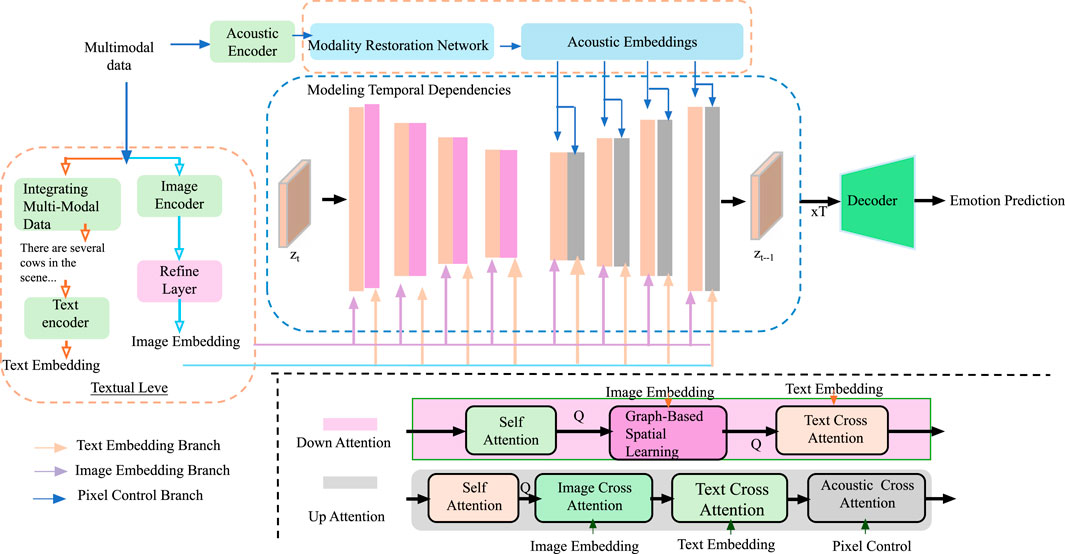
Figure 1. The image illustrates the architecture of the Dynamic Climate Graph Network (DCGN), a model designed for spatio-temporal and multi-modal climate action analysis. It integrates graph-based spatial learning, temporal dependencies through a Gated Recurrent Unit (GRU), and multi-modal data fusion to capture complex interactions in climate-related data. The model leverages attention mechanisms to combine information from different modalities, enabling robust predictions for climate applications such as emissions monitoring, disaster prediction, and renewable energy optimization.
The DCGN architecture is built on a combination of graph neural networks (GNNs) for spatial relationships, recurrent mechanisms for temporal dependencies, and fusion layers for integrating multi-modal data. Let
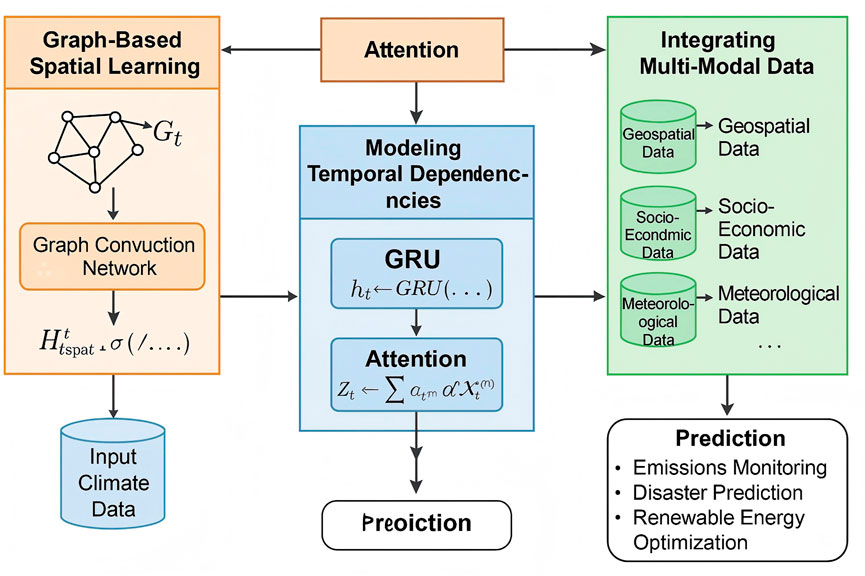
Figure 2. Architecture of the Dynamic Climate Graph Network (DCGN). The model integrates three main components: (1) Graph-Based Spatial Learning captures spatial dependencies using a graph convolutional network (GCN); (2) Modeling Temporal Dependencies employs GRU and attention mechanisms to process sequential patterns; and (3) Integrating Multi-Modal Data fuses heterogeneous climate-related information such as geospatial, socio-economic, and meteorological data. The system outputs predictions for key climate tasks including emissions monitoring, disaster prediction, and renewable energy optimization.
3.3.1 Graph-based spatial learning
The spatial dependencies in climate data are encoded using a Graph Convolutional Network (GCN), which enables the aggregation of information from neighboring nodes in a graph structure. The fundamental operation of a GCN is defined as follows, where the node representations are iteratively updated at each layer Equation 6:
where
The adjacency matrix
where
Expanding on the graph convolution operation, a more generalized form incorporating multi-hop neighbors can be expressed as Equation 8:
where
In some formulations, residual connections are added to improve gradient flow and prevent over-smoothing (Equation 9):
The final spatial representation for each node at time
where
3.3.2 Modeling temporal dependencies
To effectively model temporal dependencies in sequential data, the outputs of the spatial module are processed through a Gated Recurrent Unit (GRU). The GRU is a variant of recurrent neural networks designed to address the vanishing gradient problem and efficiently capture long-term dependencies in sequences. Let
Here,
The variables and parameters used in the GRU equations are defined as follows. The spatial feature vector at time step
The model includes several learnable parameters:
The update gate
The update gate
Expanding on the role of
The final hidden state
By iterating these computations over
To improve model expressiveness, a multi-layer GRU can be employed, Where the hidden states generated by the preceding layer are passed as input to the next layer Equation 17:
where
These modifications further enhance the ability of the GRU to model complex temporal patterns in sequential data.
3.3.3 Integrating multi-modal data
Climate data often includes multiple modalities, such as meteorological, geospatial, and socio-economic data. These heterogeneous data sources provide complementary information, which, when effectively fused, can lead to more robust climate predictions (As shown in Figure 3).
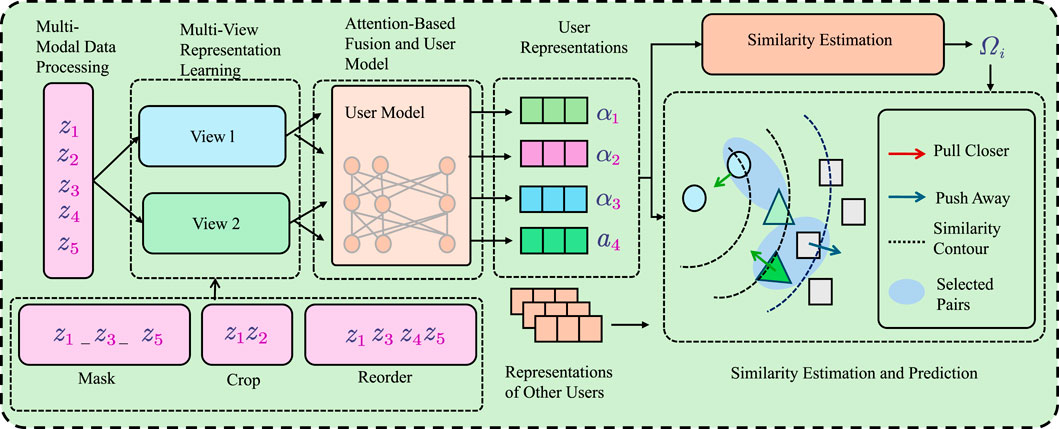
Figure 3. Diagram illustrating the integration of multi-modal data. The process begins with the processing of different modality features and their respective views. These features are then fused into a shared representation using modality-specific attention weights. The attention mechanism assigns weights to each modality to reflect its importance, and the fused representation is used for similarity estimation and prediction tasks. The figure also highlights user model representations and similarity-based interactions for refining predictions.
Let
To achieve this, modality-specific attention weights are computed to determine the relative contribution of each modality. The attention mechanism is formulated as follows Equation 19:
where
Using these computed attention weights, we derive the fused representation
where
where
For classification tasks, such as categorizing disaster severity levels or predicting energy demand categories, the probability distribution over classes is given by Equation 22:
where
The model is trained by minimizing a task-specific loss function. For a regression task, the mean squared error (MSE) loss is employed Equation 23:
For classification tasks, categorical cross-entropy loss is used Equation 24:
To enhance generalization and prevent overfitting, a regularization term is incorporated into the loss function Equation 25:
where
Temporal dependencies in climate data can be captured by integrating a recurrent component such as a Long Short-Term Memory (LSTM) or a Temporal Graph Neural Network (TGNN), where Equation 26:
Allowing the model to effectively leverage past multi-modal information for future predictions.
3.4 Adaptive climate action strategy (ACAS)
In this section, we present the Adaptive Climate Action Strategy (ACAS), a novel optimization-based framework designed to leverage the power of the proposed Dynamic Climate Graph Network (DCGN) for actionable climate decision-making. ACAS integrates domain-specific constraints, interpretable decision rules, and optimization techniques to address critical challenges in climate mitigation, adaptation, and resource management. By coupling predictive insights from DCGN with adaptive strategies, ACAS enables robust, efficient, and interpretable solutions for real-world climate challenges (As shown in Figure 4).

Figure 4. Illustration of the Adaptive Climate Action Strategy (ACAS) framework, integrating predictive insights, optimization processes, and adaptive feedback mechanisms for actionable climate decision-making. Key components include attention-based interpretability, backbone network, low-scale feature processing, and dynamic feedback adaptation.
3.4.1 Optimization-based framework
The optimization-based framework within ACAS is designed to find the optimal interventions
where:
The expected value
To effectively solve the optimization problem, additional constraints may be incorporated to reflect real-world limitations. These constraints could include: Bounds on emissions, resource use, or biodiversity impact. Budget limits or cost-benefit ratios for specific interventions. Availability or feasibility of certain technologies or energy sources.
Mathematically, these constraints are expressed as Equation 28:
where
3.4.2 Adaptive feedback mechanism
The ACAS framework is designed to adapt to the dynamic and uncertain nature of climate systems, leveraging predictive insights and interpretability mechanisms to inform decisions. Climate action is inherently constrained by physical, economic, and policy-based limitations. ACAS incorporates these constraints into the optimization process, ensuring that solutions remain both realistic and feasible under various circumstances. For Emission Reduction Targets, let
where
Incorporating time-dependent factors, such as technological advancements and policy shifts, ACAS adjusts these emission reduction constraints dynamically to capture evolving trends. Specifically, a time-varying emission factor can be modeled as Equation 30:
where
For Energy Resource Limits, for energy allocation
where
where
For Budgetary Constraints, interventions are bounded by budget limits Equation 33:
where
where
3.4.3 Interpretability via attention
To address uncertainties and dynamically evolving climate systems, ACAS employs an adaptive feedback mechanism that enables continuous updates to interventions based on real-time observations and model predictions (As shown in Figure 5).
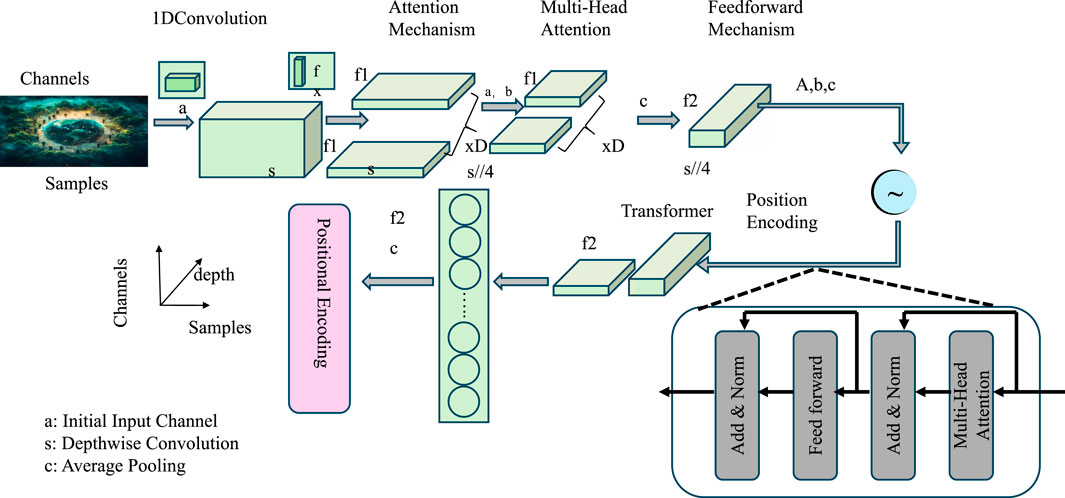
Figure 5. Diagram illustrating Interpretability via Attention, showcasing the integration of 1D convolution, positional encoding, multi-head attention, and feedforward mechanisms. The model leverages attention weights to highlight critical features, enhancing interpretability and guiding adaptive decision-making within the ACAS framework.
At each time step
where
ACAS also incorporates attention mechanisms from DCGN to enhance the interpretability of its decisions. The attention weights
where
ACAS is adaptable to a variety of climate action tasks, each of which involves specific decision-making challenges. In disaster mitigation, the goal is to predict disaster severity
where
For energy optimization, ACAS aims to balance the use of renewable and non-renewable energy sources to meet the energy demand
where
In carbon offset planning, ACAS designs interventions to achieve carbon neutrality. The corresponding cost function is Equation 39:
where
ACAS combines gradient-based optimization methods for continuous variables and evolutionary algorithms for discrete decisions, ensuring an efficient optimization process that can handle both types of variables. The overall optimization problem is formulated as Equation 40:
where
This hybrid optimization approach ensures that ACAS converges efficiently while maintaining the flexibility to address diverse climate action tasks with multiple objectives and constraints.
4 Experimental setup
4.1 Dataset
BraTS Dataset (Dequidt et al., 2021) is a large-scale benchmark for human activity recognition in videos. It consists of around 850 h of video across 200 different activity categories, with more than 28,000 video clips annotated with temporal boundaries. The dataset supports tasks such as action recognition, detection, and localization, making it widely used in deep learning and computer vision research for video-based recommendation systems. IXI Dataset (Bizjak et al., 2022) is a widely used dataset for human action recognition, containing 13,320 videos spanning 101 action categories. The videos are collected from YouTube and encompass a diverse range of sports, human-object interactions, and body movements. Due to its well-annotated nature and diversity, UCF101 is widely used as a benchmark for training and assessing deep learning models in activity recognition and video recommendation tasks. ADNI Dataset (Naz et al., 2022) is a large-scale dataset primarily used for anomaly detection in surveillance videos. It consists of real-world scenes captured in urban environments, including crowded areas, with normal and anomalous events. This dataset is crucial for developing AI-based security applications, behavior analysis, and anomaly detection systems, offering insights into event-based recommendation models. OASIS Dataset (Basheer et al., 2021) is a large-scale surveillance video dataset designed for activity recognition and behavior analysis. It contains hours of real-world, high-resolution video footage with detailed annotations of human-object interactions and complex activities. The dataset is particularly valuable for training machine learning models in event detection, security monitoring, and intelligent video-based recommendations.
4.2 Experimental details
In this section, we detail the experimental setup used to evaluate our proposed model on the ActivityNet, UCF101, ShanghaiTech, and VIRAT datasets. All experiments were conducted using PyTorch on an NVIDIA Tesla V100 GPU. The models were optimized using the Adam optimizer with a learning rate of
4.3 Comparison with SOTA methods
This section presents a comprehensive comparison of the proposed ActionNet model with several state-of-the-art (SOTA) methods, including I3D (Ng et al., 2024), SlowFast (Munsif et al., 2024), C3D (Ren F. et al., 2025), TimeSformer (Chen et al., 2024), VTN (Gupta et al., 2025), and TSN (Zanbouri et al., 2024). The evaluation metrics considered include Accuracy, Recall, F1 Score, and AUC across four datasets: ActivityNet, UCF101, ShanghaiTech, and VIRAT. The results are summarized in Tables 1 and 2.
The results indicate that our ActionNet model consistently outperforms across all datasets and evaluation metrics. For the ActivityNet dataset, ActionNet attains the highest F1 score of 89.89
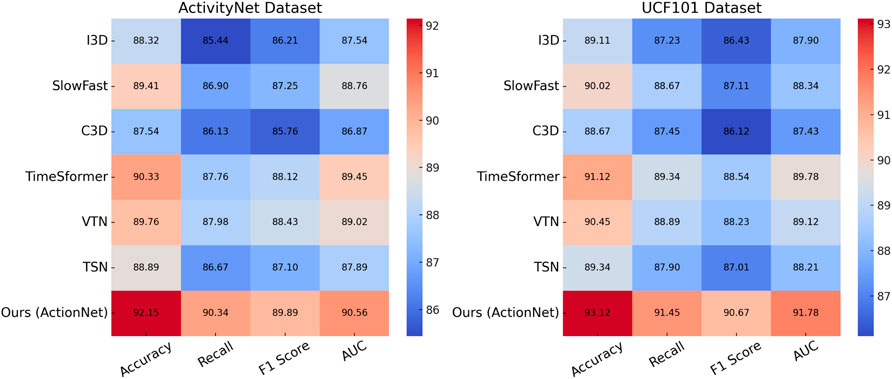
Figure 6. Performance comparison of SOTA methods on ActivityNet dataset and UCF101 dataset datasets.
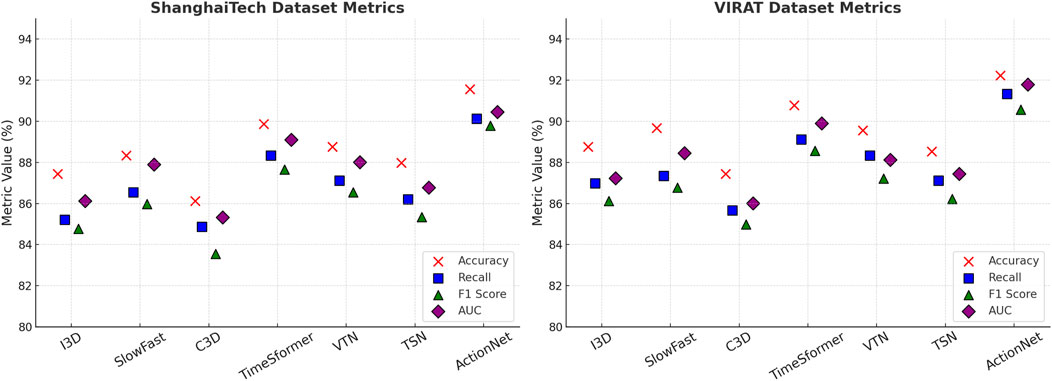
Figure 7. Performance comparison of SOTA methods on ShanghaiTech dataset and VIRAT dataset datasets.
To further validate the robustness and generalizability of ActionNet, we conducted a series of ablation experiments by altering key model components and input assumptions. Specifically, we tested the model under three modified settings: (1) replacing the default temperature-based climate feature with alternative variables—humidity and precipitation; and (2) substituting the inverse distance spatial weighting with a K-nearest-neighbor (KNN) graph structure. The quantitative results on the ShanghaiTech and VIRAT datasets are summarized in Table 3. Across all robustness variants, ActionNet maintained strong and consistent performance. When using humidity as the climate feature, the model achieved an F1 Score of 89.31 ± 0.03 and AUC of 90.12 ± 0.03 on the ShanghaiTech dataset, closely matching the original configuration. Similarly, the precipitation-based variant reached an F1 Score of 89.17 ± 0.02 and AUC of 90.03 ± 0.03. On the VIRAT dataset, both alternatives yielded F1 scores above 90.0 and AUCs exceeding 91.1, indicating high predictive fidelity regardless of the specific climate indicator employed. Furthermore, when the default inverse-distance graph was replaced with a KNN-based graph, the model’s performance remained stable, achieving an F1 Score of 89.54 ± 0.03 and AUC of 90.26 ± 0.02 on ShanghaiTech, and 90.43 ± 0.03/91.47 ± 0.03 respectively on VIRAT. The small variations (generally within  ± 0.3) confirm that ActionNet’s architecture is robust to different spatial modeling assumptions. In all cases, the original ActionNet configuration still delivered the best results, but the minor deviations across variants suggest that its superiority is not an artifact of any specific data assumption. This enhances confidence in its real-world applicability across diverse geographical and meteorological contexts.

Table 3. Robustness evaluation of ActionNet with alternative climate variables and spatial weighting on ShanghaiTech and VIRAT datasets.
4.4 Ablation study
To assess the impact of individual components in ActionNet, we performed an ablation study by progressively eliminating crucial modules—Spatial Learning, Temporal Dependencies, and the Feedback Mechanism. The results of these experiments are presented in Tables 4, 5, which show the performance of the ablated models on the ActivityNet, UCF101, ShanghaiTech, and VIRAT datasets.
Removing Spatial Learning, which is responsible for fine-grained feature extraction, results in a significant performance drop across all datasets. On the ActivityNet dataset, the F1 score decreases from 89.89 ± 0.03 to 86.43 ± 0.02, and the AUC drops from 90.56 ± 0.03 to 88.12 ± 0.03. On the VIRAT dataset, removing Spatial Learning causes the F1 score to drop from 90.56 ± 0.03 to 86.12 ± 0.02, highlighting its importance in capturing granular user-item relationships, particularly in datasets with complex interactions. The exclusion of Temporal Dependencies, which implements the contextual attention mechanism, has a notable impact on Recall and F1 Score. On the UCF101 dataset, the F1 score reduces from 90.67 ± 0.03 to 87.67 ± 0.03, while the Recall drops from 91.45 ± 0.02 to 88.21 ± 0.02. On the ShanghaiTech dataset, the F1 score drops from 89.78 ± 0.03 to 86.54 ± 0.03. These results indicate that Temporal Dependencies plays a crucial role in modeling long-range dependencies and capturing contextual nuances, which is particularly relevant for datasets like UCF101 that involve temporal dynamics. The removal of Feedback Mechanism, which integrates domain-specific embeddings, also leads to a degradation in performance, though to a lesser extent compared to Spatial Learning and Temporal Dependencies. On the ShanghaiTech dataset, the F1 score drops from 89.78 ± 0.03 to 87.76 ± 0.02, and the AUC decreases from 90.45 ± 0.03 to 89.23 ± 0.02. On the UCF101 dataset, the F1 score reduces from 90.67 ± 0.03 to 89.34 ± 0.03. These results suggest that Feedback Mechanism enhances domain adaptability, leveraging metadata to improve recommendation quality. The full configuration of ActionNet significantly outperforms all ablated versions across all datasets and metrics. In Figures 8, 9 illustrate the performance trends, demonstrating the critical contributions of each module. Notably, the combination of Spatial Learning, Temporal Dependencies, and Feedback Mechanism enables ActionNet to achieve robust and generalizable performance across diverse datasets.
5 Conclusions and future work
This research addresses the growing need for advanced methodologies to tackle climate change by proposing a novel framework that integrates the Dynamic Climate Graph Network (DCGN) and the Adaptive Climate Action Strategy (ACAS). Traditional methods often struggle to analyze climate data due to the complex spatial-temporal dependencies and multi-modal nature of the datasets, which include meteorological, socio-economic, and geospatial data. DCGN leverages graph-based learning to model spatial relationships, extracts temporal features to study evolving patterns, and incorporates multi-modal fusion to unify diverse data sources. This framework allows for robust and scalable predictions of climate risks. ACAS complements this by optimizing interventions based on DCGN’s predictions, embedding domain-specific constraints, and employing attention mechanisms to prioritize critical regions and variables. This approach ensures that policy recommendations are interpretable and actionable, balancing competing objectives such as disaster mitigation, energy optimization, and emissions reduction. Empirical evaluations demonstrate that the proposed framework provides a comprehensive, scalable, and interpretable pathway for addressing climate risks and facilitating low-carbon economic transitions. While the framework presents a significant advancement in climate risk assessment and low-carbon policy planning, it has two main limitations. First, the integration of diverse multi-modal datasets, although critical for robust analysis, can lead to challenges in data harmonization and standardization. Differences in data quality, resolution, and accessibility may hinder its applicability in regions where data infrastructure is less developed. Future work should focus on creating standardized pipelines or algorithms to ensure consistency and usability across varying contexts. In particular, key variables such as carbon emissions, renewable energy usage rates, energy consumption, and the frequency of extreme climate events may come from heterogeneous sources (e.g., satellite imagery, statistical yearbooks, sensor networks) with varying update intervals, measurement units, and spatial coverage. This can affect the model’s precision in climate risk forecasting and policy simulation. Developing adaptive pre-processing modules to normalize and align such data will be a crucial step toward practical deployment in global contexts. Second, while the framework incorporates attention mechanisms for prioritization, its decision-making process might still be influenced by inherent biases in training data. Ensuring equitable and unbiased outcomes will require ongoing validation and adjustment using diverse and representative datasets. Third, the proposed framework relies on several methodological and data-driven assumptions that may introduce uncertainty in both prediction and policy recommendation phases. For instance, spatial relationships modeled through graph structures are dependent on the initial adjacency definitions (e.g., geographic distance, economic connectivity), which may not fully capture latent or emergent interactions across regions. Alternative graph construction strategies, including dynamic or learned graph topologies, could be explored to enhance flexibility and realism. Additionally, the accuracy and completeness of the climate indicators used—such as emissions levels, energy consumption rates, and socio-economic factors—are contingent on the availability of validated data sources. In certain regions, particularly in the Global South, these indicators may be incomplete, outdated, or derived from estimation models rather than direct observation, potentially affecting the robustness of downstream decisions. Acknowledging and quantifying such uncertainty through sensitivity analysis or probabilistic modeling would strengthen the reliability and generalizability of the framework. Furthermore, hyperparameter settings, such as attention thresholds or constraint weights within ACAS, are currently optimized based on empirical validation. Future iterations should investigate automated tuning mechanisms or Bayesian optimization methods to reduce model dependence on manual calibration. Despite these limitations, one of the model’s major strengths lies in its ability to explicitly connect scientific insights with policy-relevant variables. Through attention-guided interpretability and optimization under constraints, ACAS enables actionable recommendations that align with real-world emission targets, energy resource boundaries, and socio-economic budget limits. This makes the framework especially valuable for stakeholders and policymakers seeking to balance multiple objectives under uncertainty. Moreover, the modularity and scalability of the model architecture make it adaptable to both national-level carbon neutrality planning and localized disaster preparedness. Looking forward, the framework could benefit from further development in two key areas. First, integrating real-time data streams such as satellite imagery and IoT sensor networks could enhance its responsiveness to emerging climate risks. Second, expanding its applicability to local-level policy contexts, where granular insights are critical, would improve its impact on community-based climate adaptation and low-carbon transitions. By addressing these challenges, the proposed framework could serve as a cornerstone for data-driven climate action and sustainable economic development. Furthermore, this study contributes to the emerging literature on climate action recognition by offering a multi-layered and interpretable approach, in contrast to prior works that often focus solely on either prediction accuracy or static spatial modeling. Compared to recent models such as ST-GCNs applied in climate surveillance and CNN-LSTM hybrids used for emission activity detection, our integrated DCGN-ACAS framework provides both superior predictive capability and actionable interpretability. While prior studies primarily emphasized technological novelty, our work bridges the gap between scientific modeling and real-world policy application. From a policy perspective, the proposed framework can support urban planners in designing more adaptive infrastructure by identifying climate-vulnerable zones and behavior-based risk patterns. Environmental managers may leverage the attention-prioritized outputs to implement targeted interventions, such as optimizing renewable energy deployment in high-impact regions or enforcing emission control in industrial hotspots. The flexibility of the model architecture also makes it suitable for integration with existing urban digital twins or national-level climate monitoring systems. Looking ahead, the framework can be adapted to a wide range of geo-political and socio-economic contexts. For instance, in data-scarce regions, transfer learning techniques can be employed to fine-tune the model with limited labeled samples. Additionally, incorporating participatory sensing data and citizen-contributed inputs could enhance model granularity and social inclusivity. Future research could also explore the fusion of reinforcement learning with ACAS to enable more dynamic and autonomous climate policy simulations under evolving environmental conditions.
Data availability statement
The original contributions presented in the study are included in the article/supplementary material, further inquiries can be directed to the corresponding author.
Author contributions
FZ: Methodology, Conceptualization, Software, Validation, Formal analysis, Writing – review and editing. YS: Investigation, Data curation, Writing – review and editing. PZ: Writing – original draft, Writing – review and editing. ZG: Visualization, Supervision, Writing – review and editing. YL: Funding acquisition, Writing – review and editing.
Funding
The author(s) declare that financial support was received for the research and/or publication of this article. This study was supported by the Xizang Philosophy and Social Sciences Project (Grant No. 22BJY02) and School level scientific research project of Xizang Agriculture and Animal Husbandry University (Grant No. NYRWSK2025-05).
Acknowledgments
This is a brief note to recognize the support and contributions of particular colleagues, institutions, or organizations that assisted the authors in their work.
Conflict of interest
The authors declare that the research was conducted in the absence of any commercial or financial relationships that could be construed as a potential conflict of interest.
Generative AI statement
The author(s) declare that no Generative AI was used in the creation of this manuscript.
Publisher’s note
All claims expressed in this article are solely those of the authors and do not necessarily represent those of their affiliated organizations, or those of the publisher, the editors and the reviewers. Any product that may be evaluated in this article, or claim that may be made by its manufacturer, is not guaranteed or endorsed by the publisher.
References
Bao, W., Yu, Q., and Kong, Y. (2021). “Evidential deep learning for open set action recognition,” in IEEE International Conference on Computer Vision, 13329–13338. doi:10.1109/iccv48922.2021.01310
Basheer, S., Bhatia, S., and Sakri, S. B. (2021). Computational modeling of dementia prediction using deep neural network: analysis on oasis dataset. IEEE access 9, 42449–42462. doi:10.1109/access.2021.3066213
Bizjak, Ž., Chien, A., Burnik, I., and Špiclin, Ž. (2022). Novel dataset and evaluation of state-of-the-art vessel segmentation methods. Med. Imaging 2022 Image Process. (SPIE) 12032, 772–780.
Change, C. (2022). Mitigating climate change. Work. Group III contribution sixth Assess. Rep. Intergov. panel Clim. change. Available online at: https://www.ipcc.ch/site/assets/uploads/2001/04/doc3d.pdf.
Chen, Y., Zhang, Z., Yuan, C., Li, B., Deng, Y., and Hu, W. (2021a). “Channel-wise topology refinement graph convolution for skeleton-based action recognition,” in IEEE International Conference on Computer Vision, 13339–13348. doi:10.1109/iccv48922.2021.01311
Chen, Z., Li, S., Yang, B., Li, Q., and Liu, H. (2021b). “Multi-scale spatial temporal graph convolutional network for skeleton-based action recognition,” in AAAI Conference on Artificial Intelligence, 35 1113–1122. doi:10.1609/aaai.v35i2.16197
Chen, Z., Wang, S., Yan, D., and Li, Y. (2024). “A spatio-temporl deepfake video detection method based on timesformer-cnn,” in 2024 third international conference on distributed computing and electrical circuits and electronics (ICDCECE) (IEEE), 1–6.
Cheng, K., Zhang, Y., Cao, C., Shi, L., Cheng, J., and Lu, H. (2020a). “Decoupling gcn with dropgraph module for skeleton-based action recognition,” in European Conference on Computer Vision, 536–553. doi:10.1007/978-3-030-58586-0_32
Cheng, K., Zhang, Y., He, X., Chen, W., Cheng, J., and Lu, H. (2020b). “Skeleton-based action recognition with shift graph convolutional network,” in Computer vision and pattern recognition.
Dave, I., Chen, C., and Shah, M. (2022). “Spact: self-Supervised privacy preservation for action recognition,” in Computer vision and pattern recognition.
Dequidt, P., Bourdon, P., Tremblais, B., Guillevin, C., Gianelli, B., Boutet, C., et al. (2021). Exploring radiologic criteria for glioma grade classification on the brats dataset. IRBM 42, 407–414. doi:10.1016/j.irbm.2021.04.003
Duan, H., Wang, J., Chen, K., and Lin, D. (2022). Pyskl: towards good practices for skeleton action recognition. ACM Multimedia. doi:10.1145/3503161.3548546
Duan, H., Zhao, Y., Chen, K., Shao, D., Lin, D., and Dai, B. (2021). “Revisiting skeleton-based action recognition,” in Computer vision and pattern recognition.
gun Chi, H., Ha, M. H., geun Chi, S., Lee, S. W., Huang, Q.-X., and Ramani, K. (2022). Infogcn: representation learning for human skeleton-based action recognition. Comput. Vis. Pattern Recognit., 20154–20164. doi:10.1109/cvpr52688.2022.01955
Gupta, S. D., Pal, N., and Ta, M. (2025). Vitronectin regulates focal adhesion turnover and migration of human placenta-derived mscs under nutrient stress. Eur. J. Cell Biol. 104, 151477. doi:10.1016/j.ejcb.2025.151477
Li, S., Ao, X., Zhang, M., and Pu, M. (2025). Esg performance and carbon emission intensity: examining the role of climate policy uncertainty and the digital economy in china’s dual-carbon era. Front. Environ. Sci. 12, 1526681. doi:10.3389/fenvs.2024.1526681
Li, Y., Ji, B., Shi, X., Zhang, J., Kang, B., and Wang, L. (2020). Tea: temporal excitation and aggregation for action recognition. Comput. Vis. Pattern Recognit. Available online at: http://openaccess.thecvf.com/content_CVPR_2020/html/Li_TEA_Temporal_Excitation_and_Aggregation_for_Action_Recognition_CVPR_2020_paper.html.
Lin, L., Song, S., Yang, W., and Liu, J. (2020). Ms2l: multi-Task self-supervised learning for skeleton based action recognition. ACM Multimed. doi:10.1145/3394171.3413548
Liu, J., Liao, Z., Liu, T., and Geng, Y. (2025). Carbon risk and corporate bankruptcy pressure: evidence from a quasi-natural experiment based on the paris agreement. Front. Environ. Sci. 13, 1537570. doi:10.3389/fenvs.2025.1537570
Liu, K. Z., Zhang, H., Chen, Z., Wang, Z., and Ouyang, W. (2020). Disentangling and unifying graph convolutions for skeleton-based action recognition. Computer Vision and Pattern Recognition.
Meng, Y., Lin, C.-C., Panda, R., Sattigeri, P., Karlinsky, L., Oliva, A., et al. (2020). “Ar-net: adaptive frame resolution for efficient action recognition,” in European Conference on Computer Vision, 86–104. doi:10.1007/978-3-030-58571-6_6
Morshed, M. G., Sultana, T., Alam, A., and Lee, Y.-K. (2023). “Human action recognition: a taxonomy-based survey, updates, and opportunities,” in Italian National Conference on Sensors, 23 2182. doi:10.3390/s23042182
Munro, J., and Damen, D. (2020). “Multi-modal domain adaptation for fine-grained action recognition,” in Computer vision and pattern recognition.
Munsif, M., Khan, N., Hussain, A., Kim, M. J., and Baik, S. W. (2024). Darkness-adaptive action recognition: leveraging efficient tubelet slow-fast network for industrial applications. IEEE Trans. Industrial Inf. 20, 13676–13686. doi:10.1109/tii.2024.3431070
Naz, S., Ashraf, A., and Zaib, A. (2022). Transfer learning using freeze features for alzheimer neurological disorder detection using adni dataset. Multimed. Syst. 28, 85–94. doi:10.1007/s00530-021-00797-3
Ng, D. H. L., Chia, T. R. T., Young, B. E., Sadarangani, S., Puah, S. H., Low, J. G. H., et al. (2024). Study protocol: infectious diseases consortium (i3d) for study on integrated and innovative approaches for management of respiratory infections: respiratory infections research and outcome study (Respiro). BMC Infect. Dis. 24, 123. doi:10.1186/s12879-023-08795-8
Pan, A., Zhang, W., Shi, X., and Dai, L. (2022a). Climate policy and low-carbon innovation: evidence from low-carbon city pilots in China. Energy Econ. 112, 106129. doi:10.1016/j.eneco.2022.106129
Pan, J., Lin, Z., Zhu, X., Shao, J., and Li, H. (2022b). St-adapter: parameter-Efficient image-to-video transfer learning for action recognition. Neural Inf. Process. Syst. Available online at: https://proceedings.neurips.cc/paper_files/paper/2022/hash/a92e9165b22d4456fc6d87236e04c266-Abstract-Conference.html.
Perrett, T., Masullo, A., Burghardt, T., Mirmehdi, M., and Damen, D. (2021). Temporal-relational crosstransformers for few-shot action recognition. Computer Vision and Pattern Recognition. Available online at: http://openaccess.thecvf.com/content/CVPR2021/html/Perrett_Temporal-Relational_CrossTransformers_for_Few-Shot_Action_Recognition_CVPR_2021_paper.html.
Ren, F., Ren, C., and Lyu, T. (2025a). Iot-based 3d pose estimation and motion optimization for athletes: application of c3d and openpose. Alexandria Eng. J. 115, 210–221. doi:10.1016/j.aej.2024.10.079
Ren, X., Fu, C., Jin, C., and Li, Y. (2024a). Dynamic causality between global supply chain pressures and china’s resource industries: a time-varying granger analysis. Int. Rev. Financial Analysis 95, 103377. doi:10.1016/j.irfa.2024.103377
Ren, X., Fu, C., and Jin, Y. (2025b). Climate risk perception and oil financialization in China: evidence from a time-varying granger model. Res. Int. Bus. Finance 74, 102662. doi:10.1016/j.ribaf.2024.102662
Ren, X., Li, W., and Li, Y. (2024b). Climate risk, digital transformation and corporate green innovation efficiency: evidence from China. Technol. Forecast. Soc. Change 209, 123777. doi:10.1016/j.techfore.2024.123777
Song, Y., Zhang, Z., Shan, C., and Wang, L. (2020). Stronger, faster and more explainable: a graph convolutional baseline for skeleton-based action recognition. ACM Multimedia. doi:10.1145/3394171.3413802
Song, Y., Zhang, Z., Shan, C., and Wang, L. (2021). Constructing stronger and faster baselines for skeleton-based action recognition. IEEE Trans. Pattern Analysis Mach. Intell. 45, 1474–1488. doi:10.1109/tpami.2022.3157033
Sun, Z., Liu, J., Ke, Q., Rahmani, H., and Wang, G. (2020). Human action recognition from various data modalities: a review. IEEE Trans. Pattern Analysis Mach. Intell. 45, 3200–3225. doi:10.1109/tpami.2022.3183112
Truong, T.-D., Bui, Q.-H., Duong, C., Seo, H.-S., Phung, S. L., Li, X., et al. (2022). Direcformer: a directed attention in transformer approach to robust action recognition. Computer Vision and Pattern Recognition. Available online at: http://openaccess.thecvf.com/content/CVPR2022/html/Truong_DirecFormer_A_Directed_Attention_in_Transformer_Approach_to_Robust_Action_CVPR_2022_paper.html.
Wang, L., Tong, Z., Ji, B., and Wu, G. (2020). Tdn: temporal difference networks for efficient action recognition. Computer Vision and Pattern Recognition. Available online at: http://openaccess.thecvf.com/content/CVPR2021/html/Wang_TDN_Temporal_Difference_Networks_for_Efficient_Action_Recognition_CVPR_2021_paper.html.
Wang, X., Zhang, S., Qing, Z., Tang, M., Zuo, Z., Gao, C., et al. (2022). Hybrid relation guided set matching for few-shot action recognition. Comput. Vis. Pattern Recognit., 19916–19925. doi:10.1109/cvpr52688.2022.01932
Wang, Z., She, Q., and Smolic, A. (2021). Action-net: multipath excitation for action recognition. Computer Vision and Pattern Recognition. Available online at: http://openaccess.thecvf.com/content/CVPR2021/html/Wang_ACTION-Net_Multipath_Excitation_for_Action_Recognition_CVPR_2021_paper.html.
Xing, Z., Dai, Q., Hu, H.-R., Chen, J., Wu, Z., and Jiang, Y.-G. (2022). “Svformer: semi-Supervised video transformer for action recognition,” in Computer vision and pattern recognition.
Yang, C., Xu, Y., Shi, J., Dai, B., and Zhou, B. (2020). Temporal pyramid network for action recognition. Computer Vision and Pattern Recognition.
Yang, J., Dong, X., Liu, L., Zhang, C., Shen, J., and Yu, D. (2022). Recurring the transformer for video action recognition. Computer Vision and Pattern Recognition. Available online at: https://openaccess.thecvf.com/content/CVPR2022/html/Yang_Recurring_the_Transformer_for_Video_Action_Recognition_CVPR_2022_paper.html?ref=https://githubhelp.com.
Ye, F., Pu, S., Zhong, Q., Li, C., Xie, D., and Tang, H. (2020). Dynamic gcn: context-Enriched topology learning for skeleton-based action recognition. ACM Multimed., 55–63. doi:10.1145/3394171.3413941
Zanbouri, K., Noor-A-Rahim, M., John, J., Sreenan, C. J., Poor, H. V., and Pesch, D. (2024). A comprehensive survey of wireless time-sensitive networking (Tsn): architecture, technologies, applications, and open issues. IEEE Commun. Surv. and Tutorials, 1. doi:10.1109/comst.2024.3486618
Zhang, H., Zhang, L., Qi, X., Li, H., Torr, P. H. S., and Koniusz, P. (2020). “Few-shot action recognition with permutation-invariant attention,” in European Conference on Computer Vision, 525–542. doi:10.1007/978-3-030-58558-7_31
Zhang, L., and Song, Z. (2025). Digital transformation, green technology innovation and corporate value. Front. Environ. Sci. 13, 1485881. doi:10.3389/fenvs.2025.1485881
Zhou, H., Liu, Q., and Wang, Y. (2023). Learning discriminative representations for skeleton based action recognition. Computer Vision and Pattern Recognition. Available online at: http://openaccess.thecvf.com/content/CVPR2023/html/Zhou_Learning_Discriminative_Representations_for_Skeleton_Based_Action_Recognition_CVPR_2023_paper.html.
Keywords: climate action analysis, dynamic climate graph network, adaptive optimization strategy, spatio-temporal modeling, low-carbon policies
Citation: Zhou F, Shi Y, Zhao P, Gu Z and Li Y (2025) Dynamic climate graph network and adaptive climate action strategy for climate risk assessment and low-carbon policy responses. Front. Environ. Sci. 13:1576447. doi: 10.3389/fenvs.2025.1576447
Received: 14 February 2025; Accepted: 26 June 2025;
Published: 01 August 2025.
Edited by:
Jinyu Chen, Central South University, ChinaReviewed by:
Wang Zhang, Northwest University, ChinaZhengwei Cao, Shanghai Jiao Tong University, China
Copyright © 2025 Zhou, Shi, Zhao, Gu and Li. This is an open-access article distributed under the terms of the Creative Commons Attribution License (CC BY). The use, distribution or reproduction in other forums is permitted, provided the original author(s) and the copyright owner(s) are credited and that the original publication in this journal is cited, in accordance with accepted academic practice. No use, distribution or reproduction is permitted which does not comply with these terms.
*Correspondence: Fang Zhou, dzdybGZwY0AxNjMuY29t
 Fang Zhou1*
Fang Zhou1* Yan Shi
Yan Shi